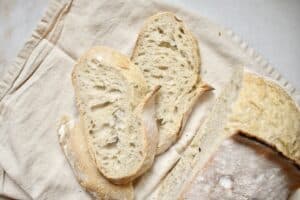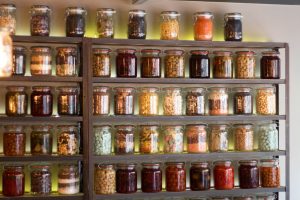…Bringing Down the Toxic Load and Increasing Nutrient Values
It’s that time of year again: holiday time! Happy Chanukah, Happy Winter Solstice, Merry Christmas, Happy Kwanzaa, and soon—Happy New Year! All over the world, people are celebrating. And celebrating almost always includes food! Holiday foods can add pounds to your waistline and toxins to your body. Let’s explore easy ways to make holiday treats healthier.

We all agree that it is so much easier to just go to the store and buy commercially made treats. While making your own treats is more work, it is also where your power lies. Your healing power, your energy power, your feel-good-about-what-you-are-eating-and-serving-power. The greatest thing about making your own holiday sweets and treats is that you control what goes in them.
Now, more than ever, it is really important to make your own cookies and cakes and other sweets. From the amount of toxins dumped on crops in the form of fertilizers and fungicides, to the glyphosate sprayed on grains to dry them, GMOs and new-fangled sugars (erythritol, sorbitol, and more!), it can be outright dangerous to eat store bought treats! (Certainly, dangerous to your liver, your blood sugar, and your pancreas!) Other not-so-good-for-you ingredients found in prepared treats and sweets include high fructose corn syrup, glucose syrup, invert sugar, modified corn starch, modified food starch, mono and di-glycerides, cellulose gum, maltodextrin, soy oil, soy flour, artificial and “natural” flavors, artificial colors, and, unfortunately, so much more!
If you are going to make your own holiday confections, here are my top three things you can do to make them less detrimental to your health and your waistline!

First: Go Organic
The easiest thing you can do is purchase organic ingredients. Remember: if you are NOT buying organic, you ARE buying glyphosate, toxins, and GMOs (unless marked Non-GMO). (More than 95% of the world’s soy is Genetically Modified. Organic foods cannot be GMO or contain GMO ingredients, by law.) When you choose to purchase organic ingredients, not only are you avoiding the toxins in commercially grown foods (which strain your liver and make you toxic), organic ingredients will also make a more nutritious treat—treats that are not only not toxic, but also nutritionally superior.
Can’t buy all organic? The top three things to be sure to have on your shopping list are organic (and pastured) eggs, organic butter (pastured is best), and organic flour.
Second: Reduce and/or Switch out your Sweetener!
As everyone knows, white (refined) sugar is the worst for us. It is nicknamed “the white poison” or “white death”. Did you know that for most recipes, you can cut the amount of sugar by half or more and still have a recipe that tastes good? Start there! What an easy way to reduce the amount of sugar you consume this holiday season—by literally cutting down the amount of sugar!
You can also make some positive nutritional impact by choosing a different sweetener. This would be either a dry sweetener or a liquid sweetener, such as maple syrup or honey. While you can swap out dry sweeteners one-to-one in a recipe, they are nutrient stealers! Liquid sweeteners are a little more difficult to swap because you are substituting a liquid for a dry ingredient. No problem: just decrease some of the liquid in the recipe or add in some dry ingredients-such as additional flour or arrowroot- or the recipe will be too wet.
If you want to start by substituting another sugar for the refined white sugar in your pantry, start with “unrefined” sugar. Unrefined sugar will retain all the molasses of the sugar cane it comes from. However, unrefined sugars contain only trace amounts of micronutrients, such as minerals, vitamins, and antioxidants. They are not a significant source of any nutrient. Unrefined sugar may be called whole cane sugar, jaggery, sucanat, or muscovado, or rock sugar. Do not fall for “raw sugar” either, it is highly refined and has even less mineral content. Raw sugar may be called turbinado, demerara, evaporated cane juice, dried cane syrup, or dehydrated cane juice.
My sweetener of choice? Maple syrup. Maple syrup contains high amounts of calcium, iron, magnesium, potassium, zinc, copper, and manganese, as well as vitamin A and B vitamins— B6, B5, B2, B1, niacin, folic acid. As far as nutrients in sweeteners go, it’s a winner for swapping. Grade B maple syrup is best, as it contains more nutrients than Grade A. How to do it? Use ¾ cup of maple syrup for every cup of white sugar in a recipe. Reduce other liquids by 4 tablespoons (¼ cup). I encourage you to try it!
Third: Use Nut Flour instead of Wheat, Grain or GF Flour
All grains are challenging to the human digestive system. Wheat flour has its own very special challenges—gluten being the best known, and most problematic. Many people with gluten sensitivity or allergy have switched from wheat flour to gluten-free flour for baking—premixed ones being the most popular. Gluten-free flour mixes are usually a mixture of tapioca starch, potato starch, arrowroot starch (are you noticing all the “starch”, which is another word for “sugar”?), brown rice flour, white rice flour, and guar gum! Some even include estrogenic soy flour. There are even “paleo” flour mixes these days, made of starchy root vegetables, like cassava. Some have high fiber coconut flour, (which can be very irritating to the gut, especially if you have leaky gut.) Don’t be fooled! All gluten-free and Paleo flour mixes are extremely high in carbohydrate, aka sugar. What to do? Try making cookies and cakes with nut flour.
Nut flour is gluten-free and low carb! It is also high in protein. “Almond flour” is the most well-known nut flour on the market, but you can also find hazelnut flour, pistachio, chestnut, and other nut flours. Almond flour is preferred because it is very mild in flavor. The others mentioned above will impart a strong flavor to whatever you are baking. If you cannot tolerate almonds for whatever reason, you can also make your own sunflower seed flour. It will also have a mild flavor.
Note: nut “flour” will have been made from blanched, skinless nuts. Nut “meal” is made from whole, unblanched nuts, including their skins. (Some people with digestive issues may experience gastric distress from the nut skins—so if you have a sensitive digestive tract, or have food sensitivities or allergies, it may be best to use nut “flour”.)
If you would like to make your own nut flour, it is quite easy to do: just grind nuts in your food processor until it is the consistency of flour. However, you can make your nut flour more easily processed (some nuts are like rocks) and easier on your digestive system by first soaking the nuts in warm water and good salt (1 tablespoon of salt for every pound of nuts; cover with warm water and let soak for about 8 hours or more.
Exception: cashews. Soak for a maximum of 6 hours or they can mold.) Once you have soaked the nuts, their skins will come off easily. Just rub them between your hands and the skins will slip right off. Crisp the nuts in the oven to dry out some of the oil (12-24 hours at the lowest temperature your oven can go—150°F best, but 170°F okay) and into the food processor they go! (Don’t bother with a dehydrator as you will be baking the flour. The enzymes you would preserve by dehydrating at a low temperature will be destroyed when you bake.) It is best to pulverize nuts in batches, about 4-6 oz of nuts at a time.
Please note: nut flour does not have gluten and cannot be substituted one-to-one for wheat or grain flour in recipes. You will have to use another ingredient to give air or lift to your baked goods: eggs. Most nut flour recipes will require 4-6 eggs or more.

Here is a recipe for a cake made with nut flour. This is a very “basic” recipe; it will taste bland or plain as is. This recipe is meant to be used as a “template” or canvas for other flavors. See below for some ideas and make it your own!
Basic Nut Flour Cake Recipe
Makes one 8-inch round or 1 bread loaf or about 12 muffins
Ingredients
2.5 cups almond or other nut or seed flour
¼-½ cup whey, plain, organic, whole milk yogurt or kefir or a combination
4 pastured eggs
¼ cup yogurt, melted pastured butter, coconut oil, or a combination
Instructions
Mix the nut flour and whey, yogurt, or kefir in a medium bowl. The consistency should be like cookie dough. (It should not be runny.)
Cover with a plate and leave on the counter at room temperature (68-72°F) for 24-48 hours.
When you are ready to make your cake, preheat the oven to 350°F.
Whisk eggs in a small bowl and then add to the flour mixture. Stir well to combine.
Add yogurt or fat and stir well to combine.
The batter should now be a porridge consistency. Add more eggs if needed.
Pour batter into a pan you have lined with parchment paper (or a cupcake tin which is lined with cups). Place in the middle of the oven and bake about 45 minutes for a cake or loaf pan; 15-20 minutes for muffins. Bake time will depend on many factors; test for doneness early by putting a toothpick in the center.
Cake/Loaf/Muffin Variations–Feel free to add any of the following to the basic recipe:
Fresh or frozen berries (thawed and drained)
Chunks of apple
Raisins or currants
Cinnamon
Cinnamon, ginger and nutmeg (gingerbread flavors)
Vanilla extract
Mashed bananas and spices (banana bread)
Raw Cacao or carob powder
Chopped nuts or seeds
Shredded carrots, raisins and spices (carrot cake)
Lemon zest and poppy seeds
Orange zest and cranberries
Raw Honey
Bon Appetit! Happy Holidays to all!
Note: if you have an anaphylactic reaction to nuts, please do not use nut flour! If you have nut allergies or sensitivities, consider trying the GAPS (Gut and Psychology Syndrome) diet to heal the cause of the allergies! More information at simplybeingwell.com and The Complete Cooking Techniques for the GAPS Diet.
Basic Nut Flour Cake Recipe
Here is a recipe for a cake made with nut flour. This is a very “basic” recipe; it will taste bland or plain as is. This recipe is meant to be used as a “template” or canvas for other flavors. See below for some ideas and make it your own!
Source: Monica Corrado
Course: Desserts
Yield: Makes one 8-inch round or 1 bread loaf or about 12 muffins
Serves:
Ingredients
- 2.5 cups almond or other nut or seed flour
- 1⁄4-1⁄2 cup whey plain, organic, whole milk yogurt or kefir or a combination
- 4 pastured eggs
- 1⁄4 cup yogurt melted pastured butter, coconut oil, or a combination
Directions
- Mix the nut flour and whey, yogurt, or kefir in a medium bowl. The consistency should be like cookie dough. (It should not be runny.)
- Cover with a plate and leave on the counter at room temperature (68-72°F) for 24-48 hours.
- When you are ready to make your cake, preheat the oven to 350°F.
- Whisk eggs in a small bowl and then add to the flour mixture. Stir well to combine.
- Add yogurt or fat and stir well to combine.
- The batter should now be a porridge consistency. Add more eggs if needed.
- Pour batter into a pan you have lined with parchment paper (or a cupcake tin which is lined with cups). Place in the middle of the oven and bake about 45 minutes for a cake or loaf pan; 15-20 minutes for muffins. Bake time will depend on many factors; test for doneness early by putting a toothpick in the center.







